Beginning woodworking does not require all of the tools in the world. But you need some.
It is tough to have too many tools. As you gain experience, you develop an appreciation of the right tool for the job. That tool will make any task safer, easier, and quicker. However, in getting started in woodworking you need to have essential tools that help in most beginning projects.
Beginning woodworking concentrates on a good quality assortment of essential tools for beginners. Most beginners already own a few tools, such as a tape measure an assortment of screwdrivers, a hammer, and an extension cord. As you learned in the first few pages of Woodworking for Beginners, safety items such as goggles, ear muffs, and a dust mask are critical.
For beginning woodworking, it is a good idea to have a versatile portable workbench with a vise, as well.
The following provides a brief description of the essential tools and where to purchase a quality one. Remember, it is always better to buy a quality woodworking tool rather than a cheap one. Normally, cheap tools have a shorter life, are less accurate and more dangerous to use.
Contractor Saw
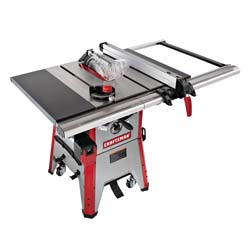
This is beneficial for beginning woodworking in a garage or small area. These smaller woodworking table saws are good cutting plywood or ripping 2×4’s.
I started out with a Delta Contractor Saw. It was okay. It lacked a precise fence, dust collection capabilities, and was underpowered. It is a good idea to find a more precise fence for a contractor saw.
You could try a circular saw & guide to cut sheet goods down to size. But it will not do everything that you may need.
As you gain experience, you might want to update to a cabinet saw for power and accuracy. It is prudent to look at 3HP or above. An enclosed cabinet is adaptable for first-rate dust collection. A precision fence is important for a serious woodworker.
Squares and Straight Edges
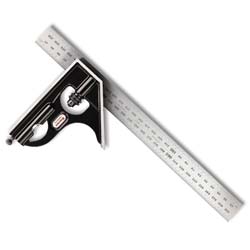
Frequently, a combination square is necessary. Most have a 45-degree angle as well. I am keen on the Starrett Combination square for precision and versatility. I purchased a cheap one from a Discount Catalog and threw it away. Don’t make that mistake.
A Straight Edge is imperative for superior work. A straight edge helps you check cupped boards, makes sure the edge is square, and line up the router bit for jointing. I prefer the Starrett 24″ Straight-edge because it is precise.
Chisels
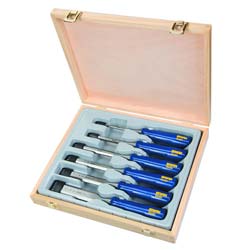
I’ve been using Marples Blue Chip Chisels for years. They are made in Sheffield, England, and rarely need sharpening. If your tools need sharpening, the Veritas Sharpening System really works!
Random Orbital Sander
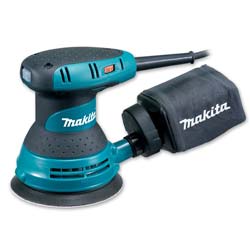
I have tried Belt Sanders, mini-Sanders, and Palm Sanders. All leave gouges and scratches. Your final finish does not need scratches. As you would guess, an ROS uses a random orbit to sand. This motion is what allows the smooth finish.
However, there is a difference in Random Orbital Sanders. You want a well-balanced sander that is is comfortable when you use it. Feel any vibrations as you turn on the sander. With excessive vibration, any sander causes fatigue, especially on large sanding projects.
For beginning woodworking, you only need a few grits of Sandpaper, such as 120 and 220 grits. These will handle nearly all of you finish work.
Sharpening System
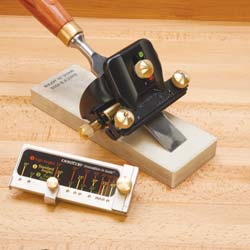
In beginning woodworking, this forces you into awkward and difficult habits. A necessary skill for woodworking is knowing how to sharpen. Better results come from sharp tools, and they are safer.
Along with a honing guide and angle jig, a good sharpening system needs water stones. The Norton Combination Water Stones are perfect for sharpening. I like the ones with different grits on each side. You can store the water stones in a Tupperware container so that they are ready to use.
Another handy sharpening system is a drill bit sharpener. These help keep your most expensive drill bits in the best shape so you don’t end up damaging them.
Clamps
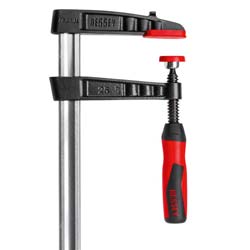
C-clamps are okay, but they are annoying with the time it takes to open and/or close. In addition, C-clamps have inadequate reach. After I tried the Bessey sliding clamp, the C-clamps get limited use.
Some of the other woodworking clamps do not live up to their propaganda. When you are gluing up a project, normally you want the parts square. For beginning woodworking, you might as well get quality clamps that will serve you over a long period of time. The Bessey K-Body has newer versions on the market. And they are hard to beat. I suggest that you pick up a couple of 24″ and 40″ sizes.
Drill and Drill Bits
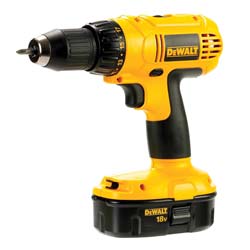
Or you can use a hand drill. Electric hand drills come in corded or cordless versions. Both come in different sizes, such 1/4″, 3/8″ or 1/2″, which equates to the maximum drill bit size. For beginning woodworking, the 3/8″ size is the best compromise. I like the cordless version for ease of use when you are not near an outlet. And the reversible variable speed allows you to use it for drilling or installing/extracting screws.
Sometimes you may need a right-angle drill, and several manufacturers sell hand drill kits with a T-Handle drill and a Right-Angle drill.
Any woodworker needs a set of countersinks to use with any drill. This allows you to recess screw heads, which is very handy.
Combination Rasp/File
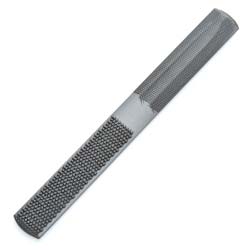
The Nicholson 4-in-1 Hand Rasp & File, 10″ Long, makes easy work for many woodworking projects.
You should be cautious since rasps cut wood aggressively. The file sections are used to make the wood smooth. The combination rasp/file can rapidly profile either simple or complex projects.
Bench Planes
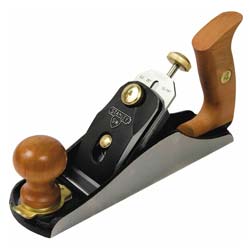
If you have quality jigs, the hand plane sees limited use. However, they are nice to take a little wood off after glue-up.
If you decide to spend some money on a hand plane, be sure to get a good one. My Record #4 Bench Plane is very sharp. You can adjust it to cut a sliver. A good bench plane should survive your lifetime.
For those who do a lot of planing, I also highly recommend an electric power planer.
Reader Interactions